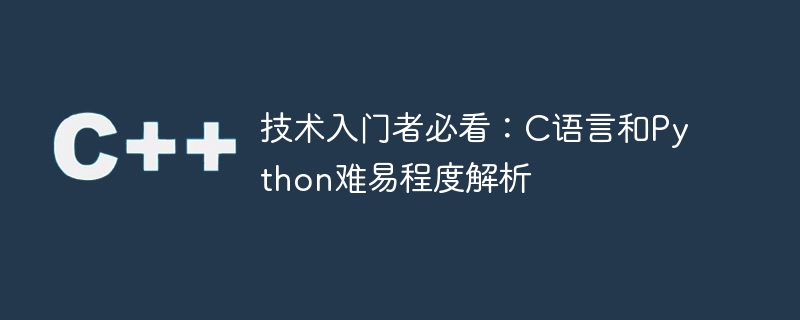

Title: A must-read for technical beginners: Analysis of the difficulty level of C language and Python, requiring specific code examples
In today's digital age, programming technology has become a An increasingly important capability. Whether you want to work in fields such as software development, data analysis, artificial intelligence, or just learn programming out of interest, choosing a suitable programming language is the first step. Among many programming languages, C language and Python are two widely used programming languages, each with its own characteristics. This article will analyze the difficulty levels of C language and Python, and demonstrate the differences between the two languages through specific code examples.
First of all, let us understand the characteristics of C language and Python. C language is an intermediate programming language that is widely used for writing system software, such as operating systems and compilers. The advantage of C language is that it is fast and powerful, but its disadvantage is that the syntax is relatively complex and requires programmers to manually manage memory, which can easily cause problems such as memory leaks. In contrast, Python is a high-level programming language that is known as a "human-friendly" programming language. Python has a concise and easy-to-read syntax, which is suitable for beginners to get started, and it has rich third-party library support to quickly develop applications.
Next, let’s compare the difficulty of C language and Python. For beginners, learning C may be more challenging than learning Python. Because C language requires programmers to manually manage memory and involves concepts such as pointer operations, beginners may feel confused. Python is more friendly, has concise syntax, and is easier for beginners to get started. In addition, Python also has the feature of dynamic typing, which eliminates the need to declare variable types in advance, which makes programming more flexible.
The following uses specific code examples to demonstrate the differences in syntax and functionality between C language and Python. The first is a simple "Hello World" program:
#includeint main() { printf("Hello, World! "); return 0; }
The above is a "Hello World" program written in C language. The code is relatively simple and uses the printf function to output a string. Next is a Python code example with the same function:
print("Hello, World!")
As you can see, Python's syntax is more concise and clear, and there is no need to write additional code like C language to achieve the same function.
In actual development, the advantage of Python lies in its rich third-party library support, which can easily perform tasks such as data analysis and network programming. The C language still has its unique advantages in systems programming, embedded development and other fields. Therefore, for developers who want to have a deep understanding of computer principles and the underlying system, learning C language is essential.
In general, whether you choose C language or Python as the starting point for learning programming, it is a good choice. Each programming language has its own unique characteristics and scope of application, and the order and depth of learning can be determined based on personal interests and needs. I hope this article can be helpful to technical beginners, and I also hope that everyone will continue to explore and make progress in the process of learning programming.
The above is the detailed content of A must-read for technical beginners: Analysis of the difficulty levels of C language and Python. For more information, please follow other related articles on the PHP Chinese website!